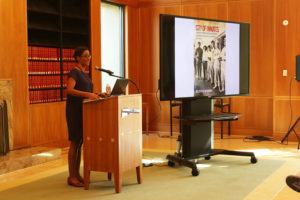Features Editor
On Friday, Oct. 6, the Kegley Institute of Ethics hosted Kelly Lytle Hernández, associate professor of history at UC Los Angeles and author of “City of Inmates: Conquest, Rebellion, and the Rise of Human Caging in Los Angeles, 1771-1965.” The Dezember Reading Room was filled with students and faculty alike interested in hearing what Hernández found through her research.
According to her findings, Hernández shared that for decades the city of Los Angeles has had the largest jail population in the United States. She shared numerous stories addressing issues from vagrancy laws to immigration. She also covered the arch of conquest in the U.S. Hernández shared her own definition of Settler Colonialism as an exploitation and elimination of indigenous communities in order to create and solidify a more permanent and racially homogeneous land.
“Incarceration has persistently remained a way to eliminate indigenous communities, and the American West has remained the epicenter for incarceration,” said Hernández.
She indicated that the Immigration Act of 1929, which for the first time made entering the U.S. as an undocumented immigrant a crime, was designed to impact Mexicans. Mexicans were especially subjected to humiliating showers and painful searches in the border entering process. An increase in unmonitored entering resulted in criminal caging of more than 7,000 Mexicans within the first year. Throughout the 1930s, Mexicans comprised no less than 85 percent or even 99 percent of detentions. No other federal crime added more Mexicans to federal prisons since the 1930s.
When Hernández began research for her book, it was difficult to gather information and records because Los Angeles had destroyed most of their records and documents pertaining to incarceration. Her research came from documents that survived the destruction by LAPD, such as songs, manifestos, and testimonies. She also used rulings pertaining to the 1910 Mexican Revolution, the Spanish Colonial era, and the 1965 Watts Rebellion. She called this compilation of research her Rebel Archives.
“When you think about history and minorities, they usually focus on the blacks and the African-Americans, and she was more focused on the Mexican immigrants, and that’s not something that people really look at. So it was really interesting to see a different perspective that you don’t really see in textbooks,” said Corina Fernandez, 18, a liberal studies major.
Due to the increase of immigrant incarceration, the U.S. opened several new federal prisons. The most infamous of which was La Tuna in 1932. The sprawling prison farm had a max capacity of 3,000. Within three months it reached that capacity.
Hernández also spoke about the Tucson Prison Camp #10 run by James Gaffney and five to six unarmed prison guards. She said that Gaffney would place runaway prisoners in The Hole, which was a hole dug in the ground with a metal grate placed over it. The prisoners would then be left in the cramped space to bake in the hot Arizona sun for several days.
“He would refer to runaways as ‘a thorn in our side’ or ‘young Mexicans with very few brains if any,’” said Hernandez. That prison camp was eventually closed down; however, the institutional racism for Mexican Americans remains today. Hernández shared an event where three years ago a group of Mexican-American youth were met in Oracle, AZ by an angry mob.
On Oct. 5, Gov. Jerry Brown signed Senate Bill 54 which made California a “sanctuary state.” This will limit the authority that local and state law enforcement agencies have to handle federal immigration issues. Federal agencies that oppose the bill often cite that illegal immigration is connected to an increase in violent crime.
“If you ask LAPD about charges against illegal immigrants, they would tell you the charges consisted of violent crimes. However, in reality, 80 percent of immigrants arrested were charged with public order charges,” said Hernández.
Oscar Zavala, 23, kinesiology major, attended the event for extra credit. After learning this information, he said, “It was interesting how she laid out everything, and it explains a lot about why the [incarceration] rates are so high. And it can be misleading when you think about Mexican incarceration. You probably think it’s more because of actual crimes, but it’s just because people are crossing over the border. It’s still a crime. A crime is a crime, but it’s not as serious as other things that could be stereotypical of Mexicans.”

Photo by Shelby Parker/ The Runner







